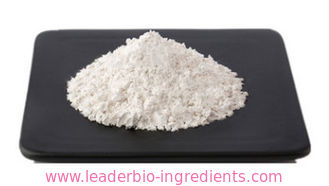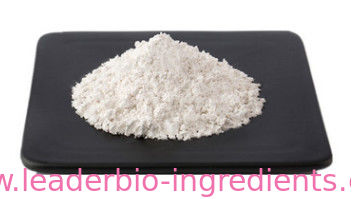| |
| BETA-CYCLODEXTRIN Chemical Properties |
| Melting point |
>260 °C (dec.)(lit.) |
| alpha |
[α]D25 +159~+165° (c=1, H2O) (After Drying) |
| Boiling point |
844.96°C (rough estimate) |
| density |
1.2296 (rough estimate) |
| FEMA |
4028 | BETA-CYCLODEXTRIN |
| refractive index |
1.7500 (estimate) |
| storage temp. |
+15C to +30C |
| solubility |
1 M NaOH: 50 mg/mL |
| pka |
11.73±0.70(Predicted) |
| form |
powder |
| color |
white |
| PH |
5.0-8.0 (1% in solution, Ph Eur) |
| optical activity |
[α]20/D +162±3°, c = 1.5% in H2O |
| Water Solubility |
Soluble in water and ammonium hydroxide. |
| Merck |
14,2718 |
| BRN |
78623 |
| Stability: |
Stable. Incompatible with strong oxidizing agents. |
| EPA Substance Registry System |
.beta.-Cyclodextrin (7585-39-9) |
| Hazard Codes |
Xi |
| Risk Statements |
36/37/38-20 |
| Safety Statements |
26-36-24/25 |
| WGK Germany |
2 |
| RTECS |
GU2293000 |
| TSCA |
Yes |
| HS Code |
29400000 |
| |
| BETA-CYCLODEXTRIN Usage And Synthesis |
| Description |
Cyclodextrins refer to a family of compounds consisting of sugar molecules bound togr in ring (cyclic oligosaccharides). It is produced from starch through enzymatic conversion. Beta-cyclodextrin is the 7-membered sugar ring molecular form of cyclodextrin. Cyclodextrin has various applications. In the pharmaceutical industry, it can be used as complexing agents for increasing the solubility of poorly soluble drug as well as increasing their bioavailability and stability. It can also alleviate the gastrointestinal drug irritation, and prevent drug-drug and drug-excipient interactions. It can also be used in food, pharmaceutical, drug delivery, and chemical industries, as well as agriculture and environmental engineering. |
| References |
https://en.wikipedia.org/wiki/Cyclodextrin
https://notendur.hi.is/thorstlo/general.pdf |
| Chemical Properties |
white powder |
| Chemical Properties |
Cyclodextrins occur as white, practically odorless, fine crystalline powders, having a slightly sweet taste. Some cyclodextrin derivatives occur as amorphous powders. |
| Chemical Properties |
A biennial herbaceous plant very common in Europe, Asia, Africa and the United States, it has a tapering fleshy root, furrowed stem, finely cut feathery leaves, umbels of small flower heads in midsummer, and capsules containing two curved narrow seeds. The plant grows to about 60 cm and it blooms from May to July. The part used is the fruit, containing approximately 15% of fixed oils and 3 to 7% of essential oil. Caraway has a warm, biting flavor with a strong, fatty, harsh undernote. |
| Chemical Properties |
beta Cyclodextrin is a virtually odorless, slightly sweet-tasting, white or almost white crystalline solid or fine powder. |
| Occurrence |
A derivative of naturally occurring starch. |
| Uses |
β-Cyclodextrin is a cyclic oligosaccharide produced from starch via enzymatic conversion. β-Cyclodextrin is commonly used to produce HPLC columns allowing chiral enantiomers separation. |
| Preparation |
Usually produced commercially from Bacillus macerans or B. circulans fermentation of starch or starch hydrolysate. |
| Production Methods |
Cyclodextrins are manufactured by the enzymatic degradation of starch using specialized bacteria. For example, β-cyclodextrin is produced by the action of the enzyme cyclodextrin glucosyltransferase upon starch or a starch hydrolysate. An organic solvent is used to direct the reaction that produces β-cyclodextrin, and to prevent the growth of microorganisms during the enzymatic reaction. The insoluble complex of β-cyclodextrin and organic solvent is separated from the noncyclic starch, and the organic solvent is removed in vacuo so that less than 1 ppm of solvent remains in the β-cyclodextrin. The β-cyclodextrin is then carbon treated and crystallized from water, dried, and collected. |
| Essential oil composition |
In addition to carvone, the oil contains d-limonene, carveol, diacetyl furfural, methyl alcohol, acetic aldehyde and other substances. Caraway oil consists of 3.5 to 7% volatile and fatty oils; resin, sugar, tannin, mucilage. |
| Taste threshold values |
Reported to have a taste threshold value lower than that of sucrose with a detection level of 3.9 to 27 ppm and a recognition level of 11 to 52 ppm |
| Pharmaceutical Applications |
Cyclodextrins are ‘bucketlike’ or ‘conelike’ toroid molecules, with a rigid structure and a central cavity, the size of which varies according to the cyclodextrin type. The internal surface of the cavity is hydrophobic and the outside of the torus is hydrophilic; this is due to the arrangement of hydroxyl groups within the molecule. This arrangement permits the cyclodextrin to accommodate a guest molecule within the cavity, forming an inclusion complex.
Cyclodextrins may be used to form inclusion complexes with a variety of drug molecules, resulting primarily in improvements to dissolution and bioavailability owing to enhanced solubility and improved chemical and physical stability.
Cyclodextrin inclusion complexes have also been used to mask the unpleasant taste of active materials and to convert a liquid substance into a solid material.
b-Cyclodextrin is the most commonly used cyclodextrin, although it is the least soluble. It is the least expensive cyclodextrin; is commercially available from a number of sources; and is able to form inclusion complexes with a number of molecules of pharmaceutical interest. However, b-cyclodextrin is nephrotoxic and should not be used in parenteral formulations. b-Cyclodextrin is primarily used in tablet and capsule formulations.
In oral tablet formulations, b-cyclodextrin may be used in both wet-granulation and direct-compression processes. The physical properties of b-cyclodextrin vary depending on the manufacturer. However, b-cyclodextrin tends to possess poor flow properties and requiresalubricant,such as 0.1% w/w magnesium stearate,when it is directly compressed.
In parenteral formulations, cyclodextrins have been used to produce stable and soluble preparations of drugs that would otherwise have been formulated using a nonaqueous solvent.
In eye drop formulations, cyclodextrins form water-soluble complexes with lipophilic drugs such as cortico. They have been shown to increase the water solubility of the drug; to enhance drug absorption into the eye; to improve aqueous stability; and to reduce local irritation.
Cyclodextrins have also been used in the formulation of solutions,suppositories, and cosmetics. |
| Safety |
Cyclodextrins are starch derivatives and are mainly used in oral and parenteral pharmaceutical formulations. They are also used in topical and ophthalmic formulations.
Cyclodextrins are also used in cosmetics and food products, and are generally regarded as essentially nontoxic and nonirritant materials. However, when administered parenterally, β-cyclodextrin is not metabolized but accumulates in the kidneys as insoluble cholesterol complexes, resulting in severe nephrotoxicity.
Cyclodextrin administered orally is metabolized by microflora in the colon, forming the metabolites maltodextrin, maltose, and glucose; these are themselves further metabolized before being finally excreted as carbon dioxide and water. Although a study published in 1957 suggested that orally administered cyclodextrins were highly toxic, more recent animal toxicity studies in rats and dogs have shown this not to be the case, and cyclodextrins are now approved for use in food products and orally administered pharmaceuticals in a number of countries.
Cyclodextrins are not irritant to the skin and eyes, or upon inhalation. There is also no evidence to suggest that cyclodextrins are mutagenic or teratogenic.
β-Cyclodextrin
LD50 (mouse, IP): 0.33 g/kg(16)
LD50 (mouse, SC): 0.41 g/kg
LD50 (rat, IP): 0.36 g/kg
LD50 (rat, IV): 1.0 g/kg
LD50 (rat, oral): 18.8 g/kg
LD50 (rat, SC): 3.7 g/kg |
| storage |
Cyclodextrins should be stored in a tightly sealed container, in a cool, dry place.Cyclodextrins are stable in the solid state if protected from high humidity. |
| Purification Methods |
Recrystallise β-cyclodextrin from water and dry it for 12hours in a vacuum at 110o, or 24hours in a vacuum at 70o. The purity is assessed by TLC on cellulose containing a fluorescent indicator. [Taguchi, J Am Chem Soc 108 2705 1986, Tabushi et al. J Am Chem Soc 108 4514 1986, Orstam & Ross J Phys Chem 91 2739 1987.] [Beilstein 19 IV 6287, 19/12 V 801.] |
| Regulatory Status |
Included in the FDA Inactive Ingredients Database: α-cyclodextrin (injection preparations); β-cyclodextrin (oral tablets, topical gels); γ-cyclodextrin (IV injections).
Included in the Canadian List of Acceptable Non-medicinal Ingredients (stabilizing agent; solubilizing agent ); and in oral and rectal pharmaceutical formulations licensed in Europe, Japan, and the USA. |
| |
| BETA-CYCLODEXTRIN Preparation Products And Raw materials |
|

